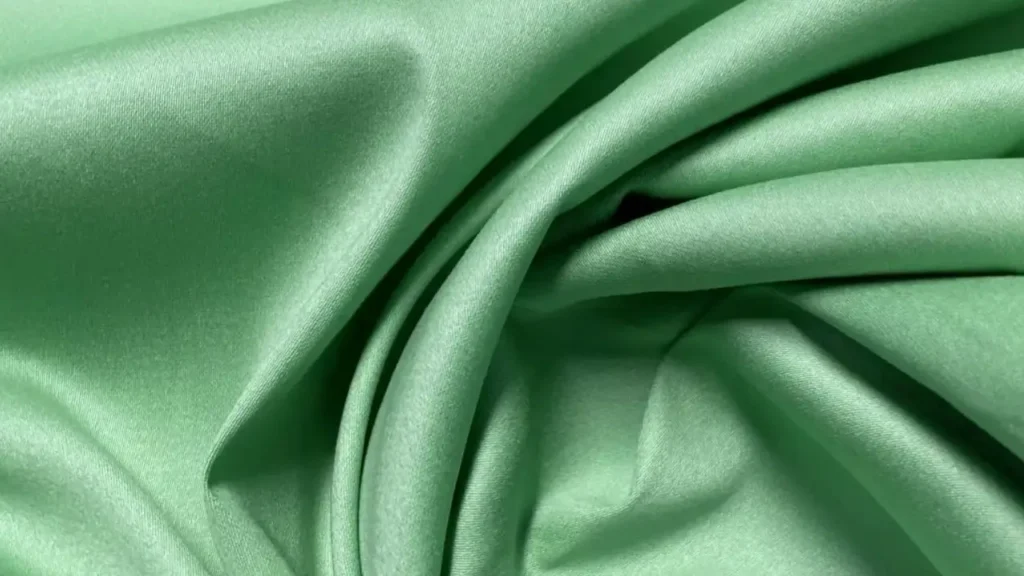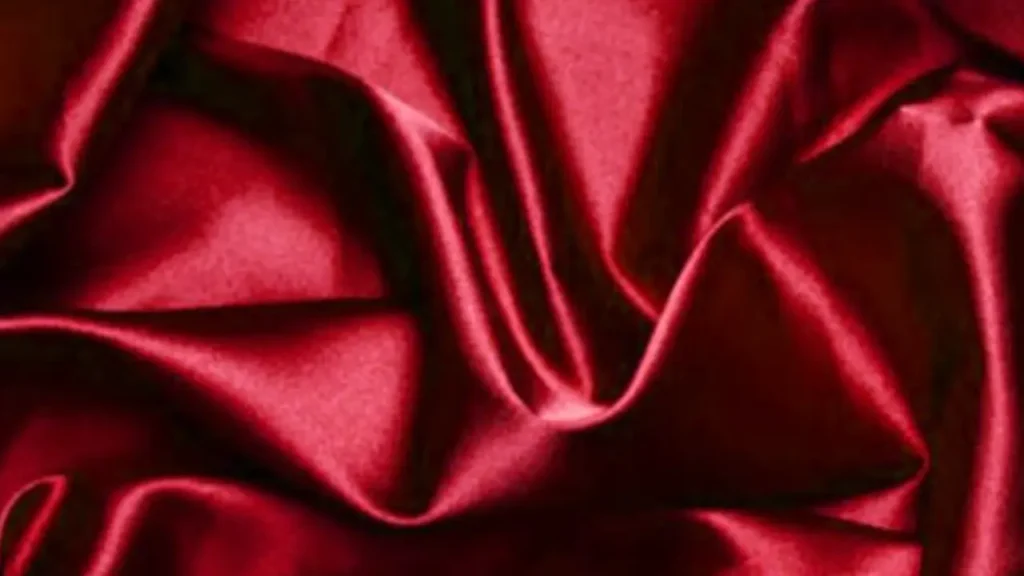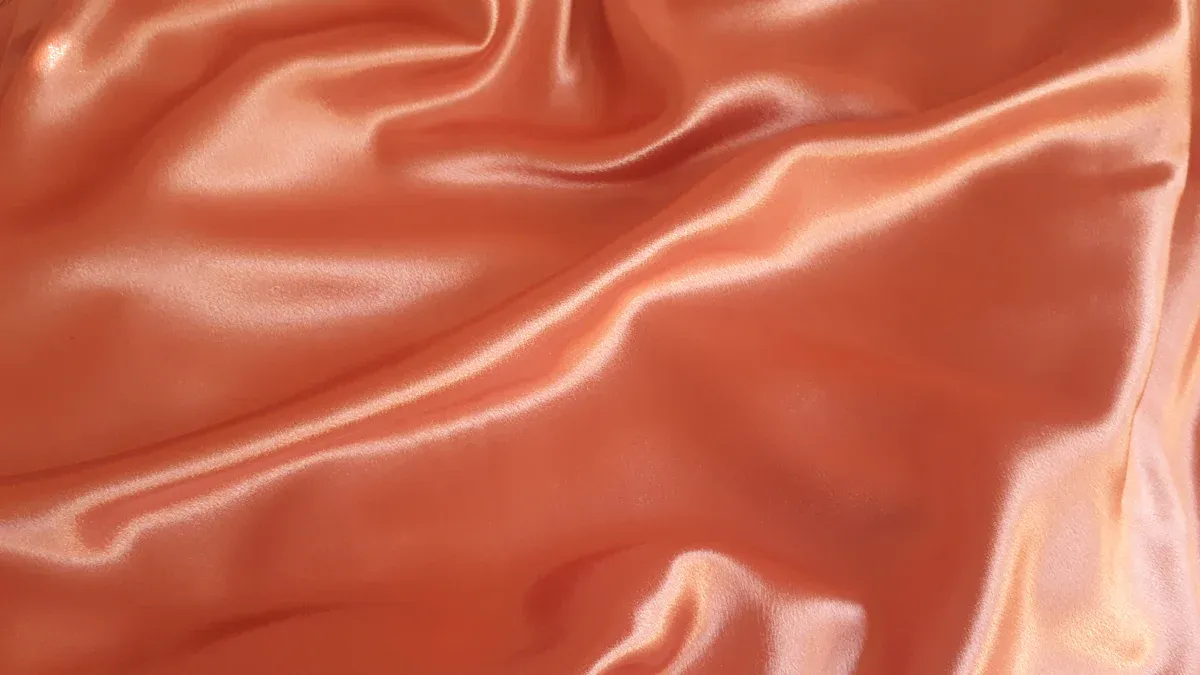The better choice between sateen fabric vs satin depends on your needs and preferences. You might love the soft, smooth touch of sateen or crave the glossy shine only satin delivers. Sateen uses cotton and a unique weave for a cozy, matte finish. Satin often feels silkier and looks shinier.
When you compare sateen fabric vs satin, think about durability, care, and cost too. F&A Fabric offers high-quality sateen and other fabrics, so you can find exactly what fits your style. Take a moment to consider what matters most—comfort, appearance, easy care, or price.
Key Takeaways
- Sateen is made from cotton and feels soft, warm, and cozy with a gentle shine, while satin is usually made from silk or synthetic fibers and has a cool, slippery feel with a high-gloss shine.
- Sateen is more durable and easier to care for, as it can be machine washed and resists wrinkles; satin needs gentle handling and may require hand washing or dry cleaning.
- Sateen is a great choice for everyday bedding, quilting, and home décor because it combines comfort, durability, and affordability.
- Satin shines with a bold, glamorous look, making it ideal for special occasion clothing and luxurious bedding but it is more delicate and costly.
- Consider your priorities like comfort, style, care, and budget when choosing between sateen and satin to find the fabric that best fits your lifestyle.
Sateen Fabric vs Satin: Basics

What Is Sateen Fabric?
When you touch sateen fabric, you’ll notice how soft and smooth it feels. Sateen comes from cotton, and manufacturers use a special weaving technique to give it a gentle sheen. This fabric often feels heavier and more durable than other cotton fabrics.
Over time, sateen has become popular for bedding, clothing, and home décor because it combines comfort with a touch of luxury. Many companies, especially in China and Italy, have mastered the art of making sateen, and you’ll find it in everything from pillowcases to elegant drapes.
What Is Satin Fabric?
Satin fabric stands out for its glossy, almost mirror-like shine. You might see satin made from silk, but you’ll also find versions made with polyester or nylon. The unique weave creates a fabric that feels silky on one side and dull on the other.
Satin often appears in evening gowns, fancy accessories, and even luxury bedding. If you want something that looks glamorous and feels smooth, satin is a classic choice. Its high sheen makes it perfect for special occasions or when you want to add a bit of drama to your look or home.
Weave and Fiber Differences
Let’s break down the main differences between sateen fabric vs satin. Both use a satin weave, but the fibers and the way they’re woven set them apart. Sateen uses cotton fibers, which are often combed and mercerized to boost their smoothness and shine.
The weave places more weft threads on the surface, giving sateen its signature soft glow and making it more durable. Satin, on the other hand, uses a warp-faced weave and is usually made from silk or synthetic filaments. This structure gives satin its high gloss but makes it a bit more delicate.
Here’s a quick table to help you compare:
| Aspect | Satin | Sateen |
|---|---|---|
| Fiber | Typically silk; also nylon or polyester | Usually cotton; sometimes rayon |
| Weave Pattern | Satin weave with warp floats | Satin weave with weft floats |
| Luster | Glossy, high sheen | Softer glow, less shiny |
| Durability | More delicate | More durable |
| Care | Requires delicate handling | Easier to care for |
Tip: If you want a fabric that’s easy to care for and lasts longer, sateen fabric might be your best bet. If you’re after a show-stopping shine, satin fabric is hard to beat.
When you compare sateen fabric vs satin, think about what matters most to you—comfort, shine, or durability. Each fabric brings something special to the table.
Sateen vs Satin: Key Differences
Sateen fabric is a cotton or other non-silk fabric woven with a satin weave structure using spun yarns. This specific weave arrangement allows the weft yarns to float over several warp yarns before interlacing, resulting in a smooth, lustrous surface on one side and a duller underside.
The more floats present, the greater the sheen exhibited by the fabric. This construction imparts a characteristically soft and often slightly heavier feel compared to plain weave cottons like percale or broadcloth.
The unique satin weave of sateen contributes to its desirable properties. It displays a subtle sheen, often likened to silk satin but typically more affordable and easier to care for. Sateen is recognized for its exceptionally soft and smooth hand, along with its graceful drape, enabling it to fall in elegant folds.
While generally breathable due to its cotton content, the tighter weave can sometimes lead to slightly more warmth retention compared to more open weaves. Sateen is also relatively durable and can undergo mercerization, a treatment that enhances its luster, strength, and dye uptake.

When you compare sateen vs satin, you’ll notice some clear differences. Each fabric brings its own personality to your home or wardrobe. Let’s break down the key features so you can decide which one fits your lifestyle best.
Texture and Feel
Touch matters. When you run your hand over sateen, you’ll feel a soft, buttery texture. Sateen sheets feel cozy and warm, almost like a gentle hug. This comes from the cotton fibers and the special weave. If you want bedding that feels inviting and smooth, cotton sateen is a great pick.
Satin, on the other hand, feels slick and cool. Satin sheets glide under your fingers. The surface is slippery and almost glassy. If you love the feeling of luxury and want something that feels cool to the touch, satin might be your favorite. Satin made from silk feels especially smooth and delicate.
Tip: If you want warmth and softness, go for sateen. If you prefer a sleek, cool touch, satin is the way to go.
Appearance and Shine
You can spot the difference between satin and sateen just by looking. Sateen has a gentle, subtle sheen. It looks elegant but not flashy. The shine comes from the way the threads float on the surface, but it never looks too bright.
Satin stands out with its high-gloss finish. The shine is bold and dramatic. Satin sheets catch the light and shimmer, making them perfect for a glamorous bedroom or a statement dress. The key features of satin sheets include their mirror-like shine and smooth surface. If you want your bedding or clothes to look extra fancy, satin delivers that wow factor.
Durability
Durability matters, especially if you want your fabric to last. Sateen is known for its strength. The cotton fibers and tight weave make it tough enough for everyday use. You can wash and use sateen sheets often, and they still look and feel great. F&A Fabric’s Luxury Quilting Fabric with US Supima cotton is a perfect example of premium sateen. It combines softness with long-lasting quality, so your quilts or bedding stay beautiful for years.
Satin is more delicate. The smooth surface can snag or catch on sharp objects. Satin sheets and clothing need gentle care. If you want something that stands up to lots of use, sateen is usually the better choice.
Care and Maintenance
You want fabrics that fit your routine. Sateen is easy to care for. Most sateen sheets can go right in the washing machine. They resist wrinkles and come out looking smooth. You don’t need to fuss over them.
Satin needs a little more attention. Many satin sheets require hand washing or a gentle cycle. High heat can damage the fibers, especially if you have satin made from silk. You might need to iron satin on a low setting or hang it to dry. If you want low-maintenance bedding or clothes, sateen is the winner.
Note: Always check the care label before washing. Following the right steps keeps your fabric looking its best.
Cost
Let’s talk about price. Sateen usually costs less than satin, especially if you compare cotton sateen to satin made from silk. Sateen sheets offer a luxurious feel without breaking the bank. You get comfort, style, and durability at a friendly price.
Satin can be more expensive, especially if you choose silk. Synthetic satin costs less, but it may not feel as nice as the real thing. If you want the look of luxury and don’t mind spending a bit more, satin is a good choice.
Quick Comparison Table
Here’s a handy table to help you see the difference between satin and sateen at a glance:
| Feature | Sateen (e.g., F&A Fabric Luxury Quilting Fabric) | Satin |
|---|---|---|
| Fiber | Cotton (often Supima) | Silk, polyester, or nylon |
| Texture | Soft, warm, buttery | Slick, cool, slippery |
| Shine | Subtle, gentle sheen | High-gloss, mirror-like |
| Durability | Strong, long-lasting | Delicate, prone to snags |
| Care | Easy, machine washable | Needs gentle care |
| Cost | Affordable luxury | Can be pricey (esp. silk) |
| Best For | Everyday bedding, quilting, home décor | Glamorous bedding, clothing |
The key features of sateen sheets are their softness, durability, and easy care. The key features of satin sheets are their high shine and silky feel.
When you look at satin and sateen side by side, you can see how each one shines in its own way. Your choice depends on what you value most—comfort, style, or easy care.
Satin vs Sateen: Best Uses

Bedding
When you shop for bedding, you probably want comfort and style. Sateen sheets feel soft and cozy, perfect for a restful night. Cotton sateen sheets breathe well, so you stay cool in summer and warm in winter. They resist wrinkles and look smooth on your bed.
Many people love sateen sheets for their gentle sheen and easy care. Satin sheets, on the other hand, feel extra silky and cool. If you want a bed that looks glamorous and feels smooth, satin sheets can give your bedroom a touch of luxury. Some people prefer satin sheets for their shine, especially in modern or elegant spaces.
Tip: If you want bedding that is easy to wash and lasts a long time, cotton sateen sheets are a smart choice. For a bold, shiny look, try satin sheets.
Clothing
You see satin in many types of clothing. Satin’s shiny surface and smooth drape make it perfect for dresses, blazers, and even leggings. It works well for both formal and casual wear. Satin fabric comes in silk, polyester, and other fibers, so you can find options for any budget.
Sateen has a more subtle finish. It feels soft and holds its shape, which makes it great for tailored shirts, dresses, and skirts. Cotton sateen sheets are also used for flowing dresses and blouses because they are breathable and resist fading. Many designers choose sateen for crisp silhouettes and comfort.
Hair Care
If you want to protect your hair, satin pillowcases and hair wraps are a popular pick. Satin sheets and pillowcases help reduce friction, so your hair stays smooth and less frizzy. People with curly or delicate hair often choose satin for this reason. Sateen pillowcases also feel gentle on your skin and hair, but satin’s slippery surface gives extra protection against tangles and breakage.
Home Décor
You can use both satin and sateen in home décor. Sateen works well for curtains, cushion covers, and even upholstery. It offers a soft touch and a subtle shine that fits many styles.
F&A Fabric’s collection includes sateen fabrics with vibrant colors and patterns, perfect for quilting and home projects. Satin adds drama to your space. Use satin for decorative pillows, table runners, or drapes when you want a bold, glossy look. Both fabrics can help you create a beautiful, inviting home.
F&A Fabric offers a wide range of sateen and satin fabrics for bedding, apparel, and home décor. You can find the perfect material for any project, whether you want comfort, style, or a bit of both.
How to Choose
Choosing between satin and sateen can feel overwhelming, but you can make it easy by focusing on what matters most to you. Let’s break it down step by step.
Comfort and Preferences
Start by thinking about how you want your fabric to feel. Do you love a soft, cozy touch? Sateen might be your best friend. It feels buttery and warm, perfect for snuggling up at night. Many people agree—about 81% of shoppers pick cotton or cotton blends for their sheets, and sateen fits right into this group.
Satin feels cool and slippery, almost like a gentle glide against your skin. If you want a fabric that feels sleek and luxurious, satin could be your top pick.
Here’s what most people look for when buying sheets:
- Softness is the number one factor (59%).
- Price matters to over half of shoppers (55%).
- Durability and longevity are also important (54% and 53%).
You might notice that only a small group—about 2%—choose satin for their bedding. Most people lean toward cotton options like sateen for everyday comfort.
Style and Look
Now, think about the style you want. Sateen gives you a gentle sheen and a classic, elegant vibe. It works well if you like a subtle shine that isn’t too flashy. Satin, on the other hand, brings bold, high-gloss drama. It’s perfect for making a statement, whether in your bedroom or your wardrobe. Satin and sateen both look beautiful, but they create very different moods.
If you want your bedding or clothes to catch the light and shimmer, satin is the way to go. If you prefer a softer, more understated look, sateen will suit you better.
Practical Needs
Let’s talk about your daily routine. Do you want something easy to care for? Sateen usually wins here. You can toss most sateen sheets in the washing machine, and they come out looking smooth. They resist wrinkles and hold up well to frequent washing. Satin needs a bit more attention. Some satin fabrics require hand washing or dry cleaning, especially if they’re made from silk.
Durability is another key point. Sateen stands up to regular use and washing. Satin can snag or wear out faster, especially if you use it every day. If you want bedding or clothing that lasts, sateen is a smart choice.
Allergies can also play a role. Cotton sateen is breathable and gentle on sensitive skin. Satin made from synthetic fibers may not breathe as well, so keep that in mind if you have allergies.
Tip: Not sure which fabric you’ll love most? Try ordering samples from F&A Fabric. You can feel the difference for yourself before making a big decision.
Quick Comparison Table
Here’s a quick look at satin vs sateen to help you decide:
| Characteristic | Sateen (Cotton) | Satin (Silk/Polyester/Nylon) |
|---|---|---|
| Feel | Soft, warm, buttery | Cool, slippery, silky |
| Appearance | Subtle sheen, classic look | High-gloss, dramatic shine |
| Durability | More durable, resists wear | Less durable, prone to snags |
| Care | Machine washable, easy care | Often needs gentle care |
| Breathability | High, good for sensitive skin | Varies, less breathable if synthetic |
| Price | Affordable luxury | Can be expensive, especially silk |
| Best For | Everyday bedding, home décor, quilting | Special occasion clothing, glam décor |
You don’t have to choose right away. Take your time, think about what you want, and maybe even test a few swatches. F&A Fabric offers samples, so you can touch and see the difference between satin and sateen before you buy.
Difference Between Satin and Sateen: Summary
You’ve learned a lot about these two popular fabrics. Let’s wrap things up with a quick summary to help you remember the main points. When you stand in the fabric aisle or browse online, you want to feel confident about your choice. Here’s what you need to keep in mind:
- Sateen uses cotton fibers and a special weave. You get a soft, warm, and slightly shiny fabric. Sateen feels cozy and works well for bedding, quilting, and home décor. It’s easy to care for and stands up to regular use.
- Satin usually comes from silk or synthetic fibers. The fabric feels cool, smooth, and slippery. Satin shines with a bold, glossy finish. You often see it in fancy clothing, glamorous bedding, and accessories. Satin needs gentle care and can snag more easily.
Tip: If you want everyday comfort and easy care, sateen is a smart pick. If you love a dramatic look and silky feel, satin might be your favorite.
Here’s a quick table to help you compare:
| Feature | Sateen (Cotton) | Satin (Silk/Polyester) |
|---|---|---|
| Feel | Soft, warm, buttery | Cool, slippery, silky |
| Shine | Subtle, gentle glow | High-gloss, dramatic |
| Durability | Strong, long-lasting | Delicate, prone to snags |
| Care | Easy, machine washable | Needs gentle handling |
| Best Use | Bedding, décor, quilts | Clothing, glam bedding |
You now know the main difference between satin and sateen. Think about what matters most to you—comfort, style, care, or price. That way, you’ll always pick the fabric that fits your lifestyle best.
Choosing between sateen and satin comes down to what you want most.
- Sateen works great for home textiles, feels soft, and is easy to care for.
- Satin shines in luxury clothing but needs gentle handling.
- Synthetic satin gives you a similar look for less money.
Think about your needs, budget, and how much care you want to give your fabric. Explore F&A Fabric’s range or try a sample. Choose the fabric that fits your lifestyle best!

FAQ
What is the main difference between sateen and satin?
Sateen uses cotton fibers and has a soft, matte finish. Satin uses silk or synthetic fibers and shines with a glossy surface. You’ll notice sateen feels warmer, while satin feels cooler and more slippery.
Can I use sateen or satin if I have sensitive skin?
Yes! Sateen, made from cotton, feels gentle and breathable. It works well for sensitive skin. Satin can also feel smooth, but synthetic versions may not breathe as well. Always check the fabric content before you buy.
Which fabric is easier to care for?
You’ll find sateen much easier to care for. Most sateen fabrics go right in the washing machine. Satin, especially silk, often needs hand washing or delicate cycles. Always read the care label for best results.
Is sateen or satin better for hot sleepers?
Sateen, made from cotton, breathes better and helps you stay cool. Satin, especially if synthetic, can trap heat. If you get hot at night, try sateen sheets for a cooler sleep.
Can I use these fabrics for quilting?
Absolutely! Sateen works great for quilting because it’s soft, strong, and easy to sew. F&A Fabric’s Luxury Quilting Fabric with US Supima cotton is a top choice. Satin can work for special quilt accents, but it’s trickier to handle.
